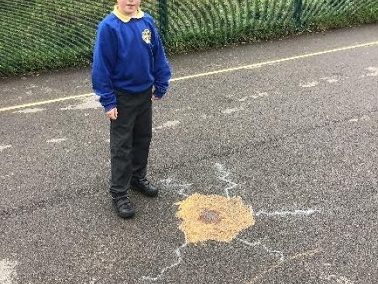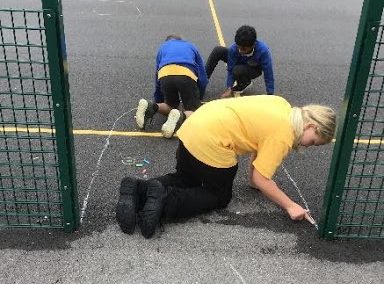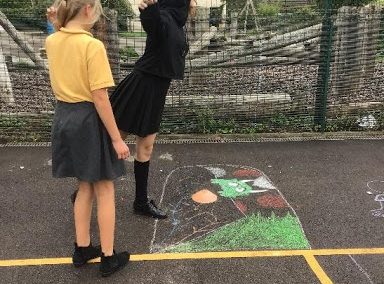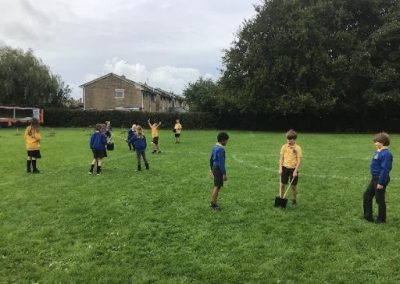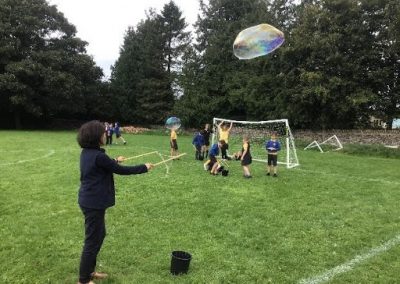Curriculum Exemplar
Journey by Aaron Becker September 2020
A whole school curriculum project focused on a single wordless picture book.
A chance for our school community to reconnect and reflect.
We started the school year off with a curriculum and an approach designed to reconnect the children both with others and with the joy of learning. The whole school focused on a book called ‘The Journey’ by Aaron Becker- https://www.storybreathing.com/. With this excellent picture book as a stimulus, we have been encouraging the children to express themselves through speaking, performing, painting, crafting, experimenting.
At Minchinhampton we try to reflect deeply about the big questions in life as well as about ourselves and others. We put a constant emphasis on self awareness and self evaluation, see https://www.minchacademy.net/our-vision-and-values/ Behind the Scenes 4. Philosophy for Children. We try to give pupils the means to share their voice and turn outwards to the world.
This September we committed to a period of time without the children writing so that we could focus on their oracy. We realise that oracy underpins wellbeing; is critical for articulating feelings and building relationships.Too often schools are based around a series of monologues as opposed to a conversation, with pupils on the receiving end. We need to move from the monologic to the dialogic. As James Britton said, ‘’Reading and writing float on a sea of talk.’’
There are so many beautiful picture books out there and ‘Journey’ is no exception. We recognise the importance of narratives in our lives. We aim for children to hear and re-tell hundreds of stories, rich with vocabulary and imagery, in their time at school. ‘The human mind seems exquisitely tuned to understand and remember stories- so much so that psychologists sometimes refer to stories as psychologically privileged, in that stories are treated differently in the memory compared with other types of material.’ (Willingham, 2004)
Journey is about a lonely girl who draws a door on her bedroom wall and steps into another world. Aided by her magic crayon she travels through this strange, new place. Shifting landscapes give way to a remarkable city where there’s a villain to confront, and the girl needs all her courage and resourcefulness in order to survive. She does, of course, and goes home with the greatest treasure of all – a friend.
Reception / Year 1’s Journey
In Midnight Class the book has given the children opportunities to orally tell their own stories. Every child has experiences of journeys they have undertaken. These may include a journey to the park or school, a journey to visit family or friends or a journey to a holiday destination when they experience a journey which may take them further from home. The book triggered other personal stories as the story in pictures developed. Stories of travelling in a boat, stories of experiences in the woods and the forest and visiting castles. Oral storytelling is very important. It develops social and emotional abilities, cognitive growth, as well as language skills. Oral storytelling is personal and unique to the storyteller.
“I walked to the woods.”
“I ran to the park to play.*
“I went in my car on the ferry to France and then to Spain.”
“I travelled on my boat and slept on it.”
‘The Journey’ has inspired role play. Role play is an effective way for children to make sense of the world around them. They learn to empathise with others when they take on the role of a character. The children made boats inspired by the boat the character drew with her red pencil to travel along the river. They used scrap, hoops and other things they found in the outdoor learning area. They worked together, took on roles and played out their adventures using their experiences of the world around them and their imaginations.
“I am going super fast in my boat. It’s a speed boat.”
“I have a computer on my boat. It shows us where we are and it does sums. It’s got a search mode.” (Used a computer keyboard from the scrap collection.)
“I am catching some fish for everyone.” (Made a fishing rod from a stick and used bean bags for fish.)
We have enjoyed drawing and mark making whilst enjoying the book. We have drawn what we would like to see through the red door drawn with the red pencil. We have drawn castles and boats and what we can see from our magic carpets.
Aqua Class also made our own magic carpets and role played our own adventures. We have made zigzag books and retold our own journey stories. We also had a very interesting P4C discussion about whether the child in the story was a boy or a girl and how we knew. Many decided that the child must be a girl because the hair is long even though her bedroom had boats and space decorations. We debated the question ‘Should boys always have short hair?’ About half the children decided “yes” because “my dad and brother have short hair so I should look the same” and “ you will go bald like daddy so you need short hair if you are a boy.” Others disagreed because “I know boys with long hair and they are still boys” and “anyone can have whatever hair they like. It is up to them and their mums and dads.”
Teal Class enjoyed listening to each other’s stories. We thought about our favourite places and people and considered where we would go if we went through the red door. We drew pictures of our favorite things and painted the red door in the centre of our pictures. We made magic carpets out of foam and practised our cutting skills to fray the edges. We journeyed on our magic carpets to foreign lands during ‘Playing and Learning’. We made magic blue lanterns to hang up in the classroom. Teal Class enjoyed looking at all the pictures and pointing out similarities and differences between the pages. We compared the different types of transport and thought about how they are useful in different places and situations.
Year 2’s Journey
Year 2 have had an enjoyable time exploring Journey by Aaron Becker. Each day, the children developed their oracy, turn taking, patience and listening skills. Their P4C skills have also improved as they have learnt to politely agree and disagree, giving reasons for their views and opinions and justifying them.
There have been plenty of opportunities for enhancing and enriching the children’s imaginative thinking and illustrative skills. They particularly enjoyed drawing what they thought would be through both the red and purple doors. Great fun was had making papier-mâché balloons and constructing the cube net to create the basket. The children had never seen so much glue before! We were impressed with the way that they developed their perseverance and determination as the balloons required three layers of papier-mâché.
We revealed around 2-3 pages of the book a day. Every time, the children were eager for more and were happy to predict what they thought would happen. Teachers acted as scribes and the classes came up with a large amount of vocabulary, often finding alternative/better words for the same thing. As we worked through the book they improved their attention to detail, making and growing links between the pages.
After we had completed the book, we played two different videos from YouTube to compare the effect that the alternative background music had. How did each one make them feel? Then the children voted on which piece they preferred. Luckily, there were plenty of opportunities for drama work; acting out the story and adding in some special sound effects.
Many of the pupils mentioned or brought in the other books in the series by the same author, Return and Quest. It was lovely to see their enthusiasm for sequels.
Some of Indigo and Azure’s thoughts:
- The girl feels lonely- where are her friends? Why are her family so busy?
- Only her scooter is colourful.
- All of her family are in separate rooms. Her mum is so busy that she is cooking and on the phone at the same time.
- A bird is moving outside of her window!
- There is a hot air balloon hanging from the ceiling. She has boat bedding!
- Her room is still grey but the forest is very green.
- Who had time to put all of those lanterns up? The fairy lights look magical.
- There are pipes in lots of these pictures. It is a water city. I hope that there are water slides.
- Why doesn’t she have any oars? Are the currents pushing her along the river? Or is it windy?
- She is looking back to catch a glimpse of her family.
- The gold on the roofs shows that the city has money and is rich.
- The guards are welcoming her but some of them are hiding.
- Perhaps she will draw her own red bird?
- They are trying to catch the bird in their nets. They are baddies. But do they want to catch the bird to look after it properly?
- The guards have not spotted her, they are looking towards the golden cage.
- The airship looks a bit like a pirate ship. It even has a plank to walk.
- Only the bird is looking in her direction, the guards are looking the opposite way.
- The guards are shocked and embarrassed that they haven’t done their jobs properly.
- The crayon might begin to draw all by itself.
- Could it be a fake crayon? Is this all a dream?
- The decorations look a bit like a Chinese temple.
- The girl is nervous and slightly cross.
- We can see the guards panicking inside of the ship. They are running. The girl has dropped her red crayon because she is releasing the bird.
- There is hardly any colour because the girl feels hopeless.
- She is celebrating- the bird is rescuing her.
- The bird wants to be her pet. It also wants to show her where it lives.
- The bird and the girl have both helped each other.
- The bird is interested in what the girl might draw next, that’s why it is hovering.
- What she might draw next: parachute, jet pack, hover board, jet plane, magic carpet, submarine, helicopter, teleportation machine…
- What could the change of colours mean? It is morning soon/something good is going to happen next
- The bird has been guiding her this entire time
- Both the bird and the girl are looking for something
- Underneath the magic carpet, the land is sandy and hot. There are crowds.
- I can see a mountain range and lots of stars in the sky- it is night. The colours in the sky are mesmerising.
- They now feel excited about their future lives/they are happy/free/exhausted/grateful
- How does the girl feel about going through the purple door? She appears unsure. She looks to the bird for a clue.
- Scared/confused/conscious – will she even fit? The red door was much larger. She lets the bird go first because she is worried and the bird is more confident.
- Is the door in the tree just for the bird? The girl is too curious not to go through. She needs to know what is behind it. She has shown that she is brave before and now she is brave enough to go through. Another adventure is waiting. She just got trapped by large guards…there must be something better behind the door because it can’t get any worse!
- The children noticed the 3 panel drawings kept repeating. We counted how many times we saw a ‘3 panel page’.
- Did the little boy have the exact same adventure?
- The boy and the girl look nearly the same, apart from one has a stripy top.
- Where did these crayons come from? Do all of the colours exist?
- I think at the end, there will be loads of different colours of birds. The girl will have a red bird to fly on.
- The boy runs to the bird with open arms- he is delighted. The smaller door had been secretly next to the boy from the start.
- The boy helps the girl up because she has just stopped crawling through the door. The bird is on his hand like a perch.
- The boy bends down to make sure that his purple circle is the same size as her red circle.
- At the end of the story- the girl doesn’t need her family any more, the boy and his bird are her new family.
- The 2 circles joining to become a bike means friendship.
- The girl leads the way at the end. She has completely changed.
Year 3/4’s Journey
Reading a picture book is not as easy as everyone thinks. Before we even opened the book, or looked at the cover, we spent time discussing the word ‘Journey’. This conversation led us down many paths and it was surprising to see what the children’s definition of a journey was. Their thinking took us to big ideas such as, “Is a step a journey?”, “Do you need to move your body to go on a journey?” and “Maybe it will be an emotional journey?”. Each page was a conversation starter and we never quite knew where it was going to take us. We took a very open-ended approach to each lesson which allowed the children to explore their interests.
Oracy was the focus and the driver of our lessons, so having a book with no words put the children in the role of the storyteller. It also allowed the children to express empathy and share opinions without feeling judged. All children felt confident to justify their own opinions and were happy to debate their ideas with each other. The bird trapped in the cage sparked a ‘should you keep animals in cages’ debate which became nuanced into ‘which animals is it ok to keep in cages and why’ and branched right out into zoos and conservation. In P4C style the children developed a ‘good question’ and took turns to contribute and listen. We’ve used P4C a lot over the last four weeks. Debating choices such as; should you take a risk or be sure and safe; what about if it is to save a friend who has saved you before?
As well as having a huge focus on oracy, we were keen for the children to express themselves through the arts. It would have been far too easy to give the children a collection of instruments to make a soundscape, so we asked them to become the instruments. The children needed to work together, almost as if they were a choir, using their bodies to create a soundtrack for their chosen page. The use of drama allowed the children to visualise their own picture book story where they fell off waterfalls and flew on their magic carpets, imagining the exciting new world around them.
The children grew as a team. They pulled together, talked, laughed, shared ideas. It was moving to see them back together again, appreciating each other. They made their own red door to pass through, expanding the scene to imagine their world beyond the door. It was fascinating and intriguing to see where their imaginations would take them. Many of the activities were team building; pulling together an oral story, building it one word at a time, each taking turns. The culmination of the project has been to make our own hot air balloons to hang up in the classroom. Bright and engaging, a metaphor for having the children back in the building, bringing light and life. As we look around, now surrounded by the children’s artistic creations which adorn every nook of our classrooms, the light and life which has been generated over the duration of this very special project will surround us for the rest of this very different year. Looking around the classrooms, we are filled with hope for the remainder of this year’s journey.
Year 5/6’s Journey
Before even showing the children ‘Journey’, we used pictures and music to explore the children’s thoughts about journeys and destinations. Like all of the phases in the school, we then started to explore the book page by page, initially with the cover and cover pages – giving the children the opportunity to share their observations, thoughts and feelings on a framework of:
- Likes & Dislikes
- Connections
- Puzzles
The children came up with many interesting observations and imaginative interpretations in the Book Talk discussions. Having been out of school for so long, they had lost none of their ability to listen to each other, to respectfully disagree and to build upon others’ ideas.
We played the children some footage of the writer, Aaron Becker, explaining how he came to write and publish ‘Journey’, and how he drew some of the characters. As we progressed through the book, the children had a go at drawing these things too – for example the bird and the air balloon. We also watched some Aaron Becker tutorials on watercolour painting because our art focus this term is colour mixing and landscape.
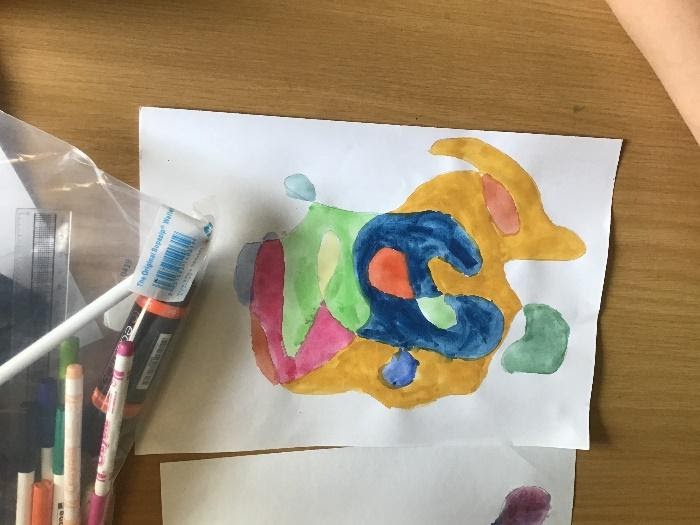
Taking a pencil for a walk and painting with a watercolour wash
We showed the children examples of street art by David Zinn, then the children were given the playground to draw their own magic doors using chalk and anything else they could find. They created short drama pieces about going through those doors to imaginary places.
At one point in ‘Journey’ the girl falls from a waterfall and quickly draws a circle. We talked about what she could be drawing – one suggestion was a bubble to float away in. That gave us the idea for a teamwork activity – making bubbles, which involved building a frame and mixing bubble liquid, then making bubbles on the school field:
After finishing Journey, the children were given the task of writing and creating a ‘stop animation’ Journey film of their own using the school’s Learn Pads and an app called Animator. This was another good opportunity for teamwork and collaboration.
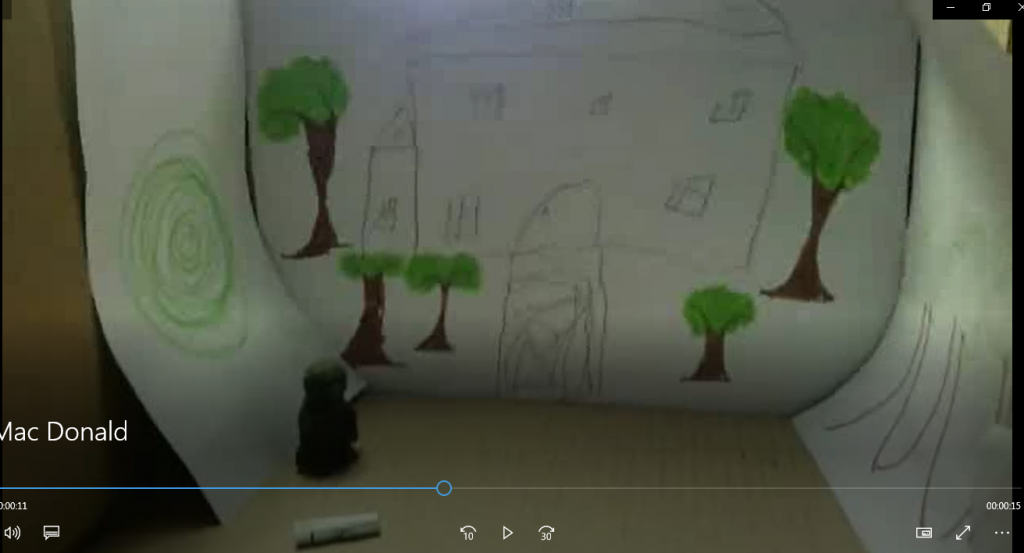
Still from a group’s stop-animation story
Using ‘Journey’ as a focus for the first few weeks of term gave the children a gentle re-introduction to school life and a chance to get used to the new systems in place for covid 19: bubbles, zones etc. Lots of art, collaborative group work, play, drama and discussion helped make the children relaxed and happy – they achieved a lot, across the curriculum, without even realising it.
In conclusion this whole school project has helped us to reinvigorate relationships and rediscover that sense of community both of which suffered during lockdown.
If you would like more information about using wordless picture books with children, please see here a helpful link – https://www.minchacademy.net/blog/2020/10/09/a-guide-to-reading-a-wordless-picture-book/

